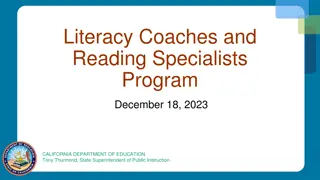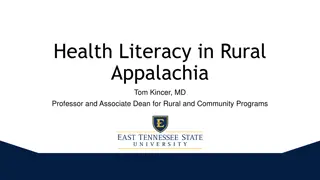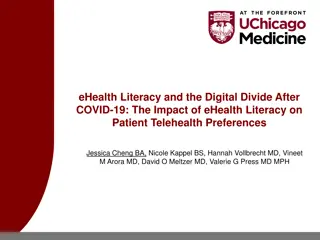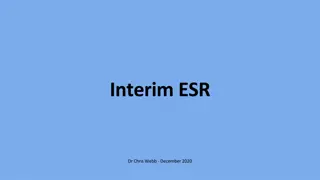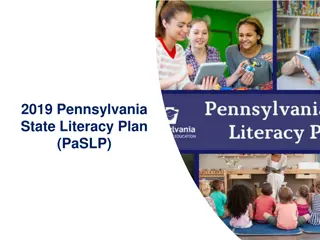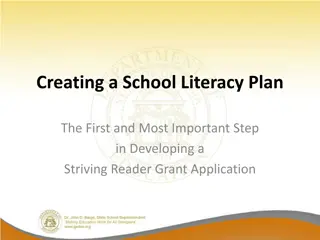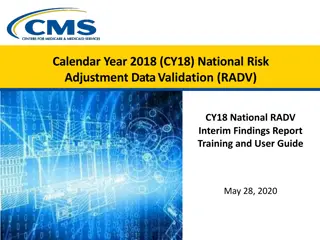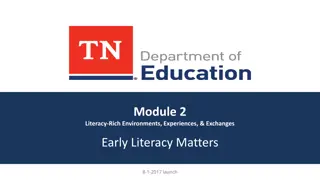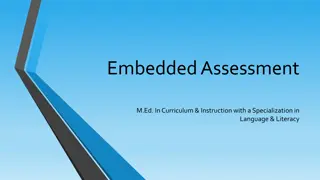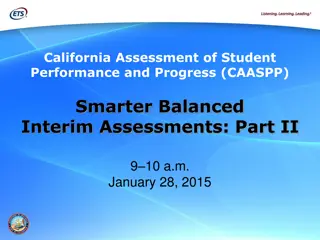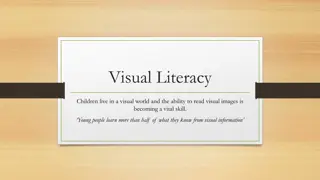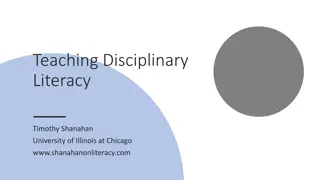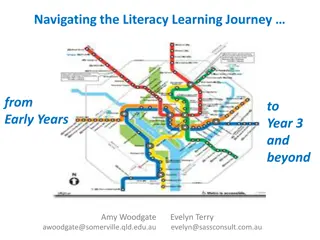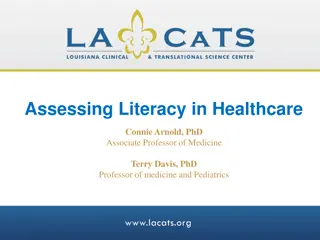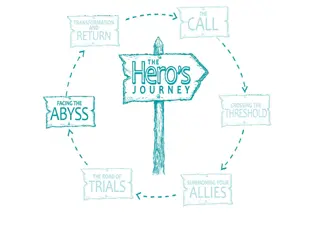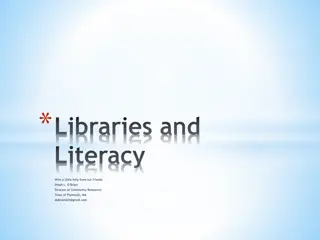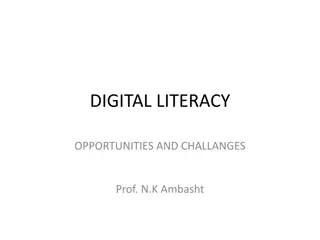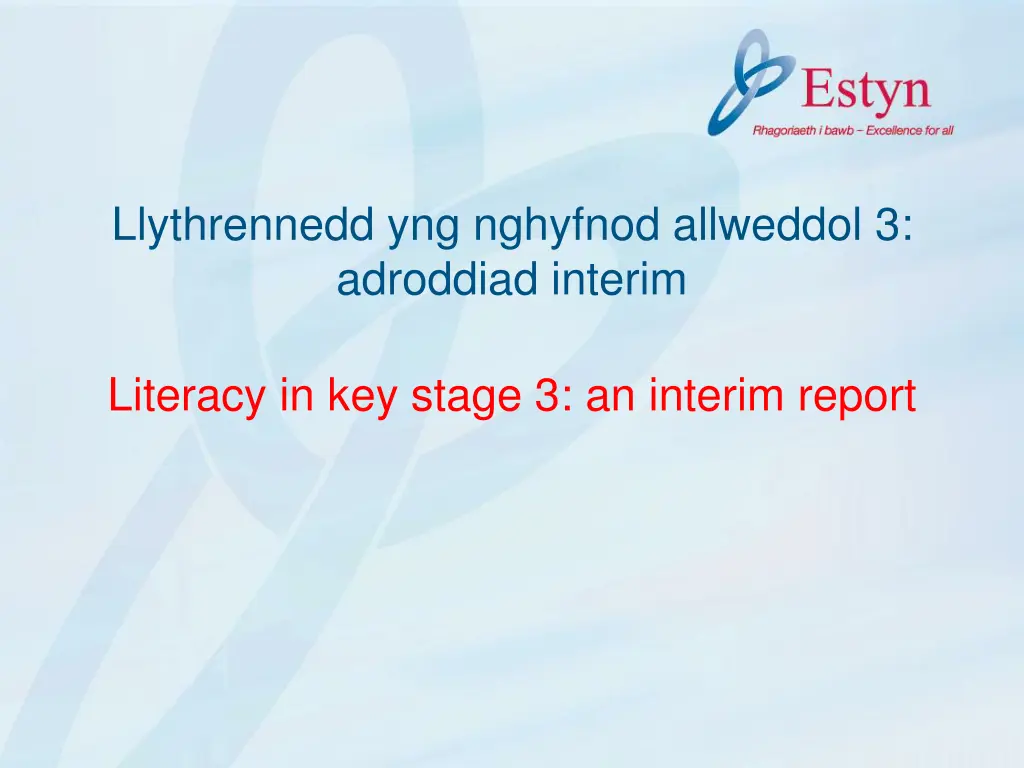
Insights into Literacy in Key Stage 3: Interim Report Findings
"Explore the interim report on literacy in key stage 3, evaluating the progress and areas of improvement in secondary schools' literacy skills development through the National Literacy and Numeracy Framework. Discover key findings and recommendations to enhance literacy standards among pupils."
Download Presentation

Please find below an Image/Link to download the presentation.
The content on the website is provided AS IS for your information and personal use only. It may not be sold, licensed, or shared on other websites without obtaining consent from the author. If you encounter any issues during the download, it is possible that the publisher has removed the file from their server.
You are allowed to download the files provided on this website for personal or commercial use, subject to the condition that they are used lawfully. All files are the property of their respective owners.
The content on the website is provided AS IS for your information and personal use only. It may not be sold, licensed, or shared on other websites without obtaining consent from the author.
E N D
Presentation Transcript
Llythrennedd yng nghyfnod allweddol 3: adroddiad interim Literacy in key stage 3: an interim report
Cefndir Background This report is the second in a series, published in response to a request for advice in the Minister's annual remit letter to Estyn for 2013-2014. Hwn yw r ail adroddiad mewn cyfres, a gyhoeddwyd mewn ymateb i gais am gyngor yn llythyr cylch gwaith y Gweinidog i Estyn ar gyfer 2013-2014. It looks at standards in literacy at key stage 3, and how a selection of secondary schools is developing pupils literacy skills across the curriculum with a particular reference to the implementation, and impact of the first year of the literacy component of the National Literacy and Numeracy Framework (LNF). Mae n edrych ar safonau mewn llythrennedd yng nghyfnod allweddol 3, a sut y mae detholiad o ysgolion uwchradd yn datblygu medrau llythrennedd disgyblion ar draws y cwricwlwm, gan gyfeirio n benodol at weithredu, ac effaith blwyddyn gyntaf elfen llythrennedd y Fframwaith Llythrennedd a Rhifedd Cenedlaethol (FfLlRh). For this report inspectors visited 21 secondary schools and invited a further 40 to respond on-line Ar gyfer yr adroddiad hwn, ymwelodd arolygwyr 21 o ysgolion uwchradd, a gwahoddwyd 40 ysgol arall i ymateb ar- lein
Prif ganfyddiadau Main findings Yn y ddwy flynedd diwethaf, barnwyd bod safonau cyffredinol yn rhagorol mewn rhyw un o bob naw ysgol uwchradd a arolygwyd, ac yn dda mewn bron i ddwy ran o bump, sef cyfran debyg i r ddwy flynedd flaenorol. Mae disgyblion yn defnyddio u medrau llythrennedd yn dda yn yr ysgolion hyn. In the last two years, standards in general were judged excellent in about one-in-nine secondary schools inspected, and good in close to two-in- five, which is similar to the previous two years. Pupils use their literacy skills well in these schools. Although standards in English and Welsh first language at level 5 and above continue to rise, the standards of pupils literacy remain much as they were two years ago at the time of the baseline survey. In the majority of schools inspected, and visited as part of the survey, the overall standard of pupils' literacy is adequate. Er bod safonau mewn Cymraeg a Saesneg mamiaith ar lefel 5 ac uwch yn parhau i godi, mae safonau llythrennedd disgyblion yn aros fwy neu lai r un fath ag oeddent ddwy flynedd yn l, adeg cynnal yr arolwg gwaelodlin. Ym mwyafrif yr ysgolion a arolygwyd, ac a ymwelwyd nhw fel rhan o r arolwg, digonol yw safon gyffredinol llythrennedd disgyblion.
Prif ganfyddiadau Main findings In a majority of the schools visited as part of the survey, the provision for the development of pupils' literacy skills is only adequate. Since the baseline survey, many schools have increased opportunities, across the curriculum, for pupils to produce extended writing. In most schools, there is an improved awareness among teachers of the need to develop pupils reading and oral skills. However, the shape of provision overall remains similar to that reported in the baseline survey. Mewn mwyafrif o r ysgolion yr ymwelwyd nhw fel rhan o r arolwg, dim ond digonol yw r ddarpariaeth ar gyfer datblygu medrau llythrennedd disgyblion. Ers yr arolwg gwaelodlin, mae llawer o ysgolion wedi cynyddu cyfleoedd, ar draws y cwricwlwm, i ddisgyblion gynhyrchu gwaith ysgrifennu estynedig. Yn y rhan fwyaf o ysgolion, mae gwell ymwybyddiaeth ymhlith athrawon o r angen i ddatblygu medrau darllen a medrau llafar disgyblion. Fodd bynnag, mae ffurf y ddarpariaeth gyffredinol yn parhau n debyg i hynny yr adroddwyd amdani yn yr arolwg gwaelodlin.
Prif ganfyddiadau Main findings Mae cynnydd o ran gweithredu r FfLlRh wedi bod yn arafach na r disgwyl am nifer o resymau, gan gynnwys: Progress in implementing the LNF has been slower than expected for several reasons, including: y cyfnod arweiniol byr nad oedd yn caniat u amser i ysgolion baratoi n ddigon da; yr anawsterau o ran cael cymorth yn sgil gwefan nad yw n hawdd ei defnyddio; mynediad annigonol i leoedd hyfforddi; mwyafrif o ysgolion heb ddealltwriaeth glir o ddilyniant mewn safonau llythrennedd disgyblion; ac arweiniad annigonol ar asesu, gan gynnwys rhoi enghreifftiau o safonau llythrennedd a deunyddiau prawf. the short lead-in period not allowing schools time to prepare well enough; the difficulties in accessing support due to a website that is not user-friendly; insufficient access to training places; a majority of schools not having a clear understanding of progression in standards of pupils literacy; and insufficient guidance on assessment including exemplification of standards of literacy and of test materials.
Prif ganfyddiadau Main findings Mae bron pob un o r ysgolion yr ymwelwyd nhw wedi gwneud rhywfaint o gynnydd o ran cynllunio ar gyfer datblygu medrau llythrennedd disgyblion ers yr arolwg gwaelodlin. Mae r ysgolion hyn yn nodi llythrennedd fel blaenoriaeth ysgol gyfan, ac yn gweld gwerth y FfLlRh. Mewn lleiafrif o ysgolion, cynhwysir llythrennedd yn briodol mewn cynlluniau datblygu pwnc. Lle mae gwaith i w wneud o hyd, nid yw pob pwnc yn cynnwys llythrennedd yn eu cynlluniau, ac mae meini prawf llwyddo yn aneglur ac yn ymwneud darpariaeth yn bennaf yn hytrach na deilliannau mesuradwy (A1). Nearly all the schools visited have made some progress in planning for the development of pupils' literacy skills since the baseline survey. These schools identify literacy as a whole-school priority and see the value of the LNF. In a minority of schools, literacy is included appropriately in subject development plans. Where there is still work to do, not all subjects include literacy in their plans and success criteria are vague and relate mainly to provision rather than to measureable outcomes (R1). Mae r gwaith o asesu ac olrhain medrau llythrennedd disgyblion yn dal heb ei ddatblygu digon yn y rhan fwyaf o ysgolion, ac eithrio ar gyfer disgyblion sy n cymryd rhan mewn rhaglenni ymyrraeth penodol, er mae gan y rhan fwyaf o ysgolion systemau olrhain addas i fonitro cynnydd mewn pynciau (A2). The assessment and tracking of pupils' literacy skills remain under-developed in most schools, other than for pupils who take part in specific intervention programmes, although most schools have suitable tracking systems to monitor progress in subjects (R2). Mae llawer o ysgolion wedi amlinellu cyfleoedd trawsgwricwlaidd ar gyfer datblygu medrau llythrennedd disgyblion, ond ychydig ohonynt sydd wedi gwneud digon o gynnydd o ran sicrhau ansawdd y cyfleoedd hynny, neu wrth gynllunio ar gyfer dilyniant i ddatblygu medrau disgyblion. Many schools have mapped cross-curricular opportunities for the development of pupils' literacy skills, but few have made enough progress in quality assuring those opportunities, or in planning for progression in the development of pupils' skills.
Prif ganfyddiadau Main findings Mae mwyafrif o ysgolion wedi cynyddu r disgwyliad i ddisgyblion gwblhau mwy o ysgrifennu estynedig. Fodd bynnag, nid yw r dulliau o wella ansawdd a chywirdeb technegol ysgrifennu disgyblion yn cael eu cymhwyso n gyson ar draws y cwricwlwm. Mae addysgu ysgrifennu yn dal heb ei ddatblygu n ddigonol mewn lleiafrif o ysgolion. Rhoddir y ffocws ysgol gyfan mwyaf aml ar gyflwyno dull cyson o farcio llythrennedd. Mae cael dull marcio ysgol gyfan wedi cyflwyno mwy o gysondeb mewn arfer, er ei fod yn parhau n amrywiol mewn llawer o ysgolion (A3). Mewn ychydig o ysgolion, mae datblygiad llythrennedd disgyblion yn well mewn pynciau heblaw am Gymraeg neu Saesneg. Yn yr ysgolion hyn, mae athrawon Cymraeg a Saesneg yn mabwysiadu dull rhy llenyddol o addysgu u pynciau ac yn canolbwyntio gormod ar ddealltwriaeth a gwerthfawrogiad disgyblion o r testun llenyddol yn hytrach na datblygu medrau llythrennedd penodol. A majority of schools have increased the expectation for pupils to complete more extended writing. However, the approaches to improving the quality and technical accuracy of pupils' writing are not applied consistently across the curriculum. The teaching of writing remains underdeveloped in a minority of schools. The most frequent whole-school focus is on introducing a consistent approach to the marking of literacy. Having a whole-school approach to marking pupils work has introduced greater consistency in practice, although it remains variable in many schools. (R3). In a few schools, the development of pupils' literacy is better in subjects other than English or Welsh. In these schools, English and Welsh teachers take an overly literary approach to their subjects and focus too much on pupils understanding and appreciation of the literary text rather than on developing specific literacy skills.
Prif ganfyddiadau Main findings Mae llawer o ysgolion yn nodi arsylwadau o wersi a chraffu ar lyfrau fel y dull o fonitro ac arfarnu strategaethau ar gyfer gwella llythrennedd. Mewn llawer o achosion, fodd bynnag, nid yw r gweithgareddau hyn yn canolbwyntio n ddigon manwl ar effaith y ddarpariaeth. Nid yw athrawon yn gyffredinol yn deall sut i farnu safonau llythrennedd ar draws y cwricwlwm (A4). Mae lleiafrif o ysgolion wedi gwneud cynnydd da o ran datblygu medrau darllen lefel uwch disgyblion, fel cyfosod, defnyddio awgrym, dod i gasgliad a rhagweld. Fel arfer, mae disgyblion yn gwneud y cynnydd hwn mewn gwersi Saesneg, Cymraeg a r dyniaethau. Fodd bynnag, nid yw r mwyafrif o ysgolion yn cynllunio gweithgareddau sy n herio disgyblion mwy abl yn gyson. Mae mwyafrif o staff yn parhau i gynorthwyo datblygu medrau darllen ac ysgrifennu lefel uwch disgyblion trwy ddarpariaeth bresennol y cwricwlwm yn hytrach nag mewn ymateb i r FfLlRh. Mae hyn yn golygu nad yw r ddarpariaeth ar gyfer datblygu medrau darllen ac ysgrifennu yn ddilyniannol ac nid yw n adeiladu ar yr hyn y mae disgyblion yn ei wybod a i ddeall yn barod (A5). Many schools identify lesson observations and book scrutiny as the means to monitor and evaluate strategies for improving literacy. However, in many cases, these activities do not focus sharply enough on the impact of the provision. Teachers generally do not understand how to judge standards of literacy across the curriculum (R4). A minority of schools have made good progress in developing pupils higher-order reading skills, such as synthesis, inference, deduction and prediction. Usually, pupils make this progress in English, Welsh and humanities lessons. However, the majority of schools do not plan activities that consistently challenge more able pupils. A majority of staff continue to support the development of pupils higher-order reading and writing skills through existing curriculum provision rather than in response to the LNF. This means that the provision for the development of reading and writing skills is not progressive and does not build on what pupils already know and understand (R5).
Prif ganfyddiadau Main findings Mae ansawdd a graddau r cymorth i ysgolion i ddatblygu llythrennedd disgyblion wedi bod yn amrywiol, ac wedi cael effaith gyfyngedig. Mewn lleiafrif o ysgolion, mae r awdurdod neu r consortiwm lleol wedi darparu hyfforddiant ar ymddygiadau darllen, addysgu tactegol a defnyddio offer diagnostig y FfLlRh. Nid yw r cymorth hwn wedi bod ar gael mewn mwyafrif o ysgolion, fodd bynnag, a chyfleoedd cyfyngedig fu i rannu arfer dda gydag ysgolion eraill. Mae llawer o ysgolion yr ymwelwyd nhw yn anfodlon r cymorth a gynigir iddynt gan yr awdurdod lleol a r consortiwm rhanbarthol (A6 ac A7). Mae cydlynydd llythrennedd gan bron pob ysgol, gyda chefndir addysgu mewn Cymraeg neu Saesneg ac yn meddu ar fedrau llythrennedd addas. Mae hon yn gyfran uwch nag yr adroddwyd amdani yn yr arolwg gwaelodlin. Mae trosiant staff yn her i ysgolion, ac fe wnaeth dros hanner yr ysgolion benodi u cydlynwyr llythrennedd o fewn y flwyddyn ddiwethaf. Mae llawer o r cydlynwyr newydd hyn yn dal i ymgartrefu yn eu swyddi. The quality and extent of the support for schools to develop pupils literacy have been variable and have had limited impact. In a minority of schools, the local authority or consortium has provided training on reading behaviours, tactical teaching and the use of the LNF diagnostic tools. However, in a majority of schools, this support has not been available and there have been limited opportunities to share best practice with other schools. Many of the schools visited are dissatisfied with the support offered to them by the local authority and the regional consortium (R6 and R7). Nearly all schools have a literacy co-ordinator, with a teaching background in English or Welsh and with suitable literacy skills. This is a higher proportion than reported in the baseline survey. Staff turnover is a challenge for schools and over half of the schools appointed their literacy co-ordinators within the last year. Many of these new co-ordinators are still settling into the post.
Prif ganfyddiadau Main findings Annual national reading test results are available to schools to monitor the reading progress of all pupils. However, schools make limited use of these test results to plan learning experiences across the curriculum. In many schools, the information is available, but viewed as the property of the English or Welsh department rather than as a whole- school resource. Mae canlyniadau r profion darllen cenedlaethol blynyddol ar gael i ysgolion er mwyn monitro cynnydd darllen pob disgybl. Fodd bynnag, defnydd cyfyngedig y mae ysgolion yn ei wneud o ganlyniadau r profion hyn i gynllunio profiadau dysgu ar draws y cwricwlwm. Mewn llawer o ysgolion, mae r wybodaeth ar gael, ond fe i gwelir fel eiddo r adran Gymraeg neu Saesneg yn hytrach nag fel adnodd ysgol gyfan.
Argymhellion Recommendations Dylai ysgolion: Schools should: A1 weithredu dull trawsgwricwlaidd dilyniannol a chydlynus o ddatblygu medrau llythrennedd disgyblion, yn unol r disgwyliadau yn y FfLlRh; R1 implement a progressive and well co- ordinated cross-curricular approach to developing pupils literacy skills, in line with the expectations in the LNF; R2 track and monitor the progression in pupils literacy skills against the end-of- year expectations of the LNF; A2 olrhain a monitro r dilyniant mewn medrau llythrennedd disgyblion yn erbyn disgwyliadau diwedd blwyddyn y FfLlRh; R3 encourage English and Welsh subject experts to take the lead in improving links between subjects to support a consistent, progressive approach to developing pupils' literacy skills; A3 annog arbenigwyr pwnc Cymraeg a Saesneg i arwain ar wella cysylltiadau rhwng pynciau i gefnogi dull cyson, dilyniadol o ddatblygu medrau llythrennedd disgyblion;
Argymhellion Recommendations A4 darparu cyfleoedd da a chymorth ar draws y cwricwlwm i ddisgyblion wella u hysgrifennu, gan gynnwys ei gywirdeb technegol; a A5 monitro ac arfarnu effaith strategaethau ar gyfer gwella medrau llythrennedd disgyblion. R4 provide good opportunities and support across the curriculum for pupils to improve their writing, including its technical accuracy; and R5 monitor and evaluate the impact of strategies for improving pupils' literacy skills. Dylai awdurdodau lleol / consortia rhanbarthol: Local authorities / regional consortia should: A6 egluro rolau awdurdodau lleol, consortia a r partneriaid cymorth cenedlaethol ar gyfer hyfforddi a chefnogi ysgolion wrth roi r FfLlRh ar waith; a R6 clarify the roles of local authorities, consortia and the national support partners for training and supporting schools in the implementation of the LNF; and A7 gwella r defnydd o gyfarfodydd clwstwr pontio i sefydlu dull cyson o addysgu medrau llythrennedd. R7 improve the use of transition cluster meetings to establish a consistent approach to the teaching of literacy skills.
Argymhellion Recommendations Dylai Llywodraeth Cymru: The Welsh Government should: A8 gael i ysgolion cyn gwneud datblygiadau pellach i r fframwaith; drefnu bod deunyddiau cymorth ar R8 make support materials for schools available in advance of further developments of the framework; A9 gael mynediad yn rhwydd i ddeunyddiau cymorth; a gwneud yn si r y gall pob ysgol R9 make sure that all schools can access support materials easily; and A10 asesu a chynnig enghreifftiau o safonau llythrennedd a ddisgwylir ar draws pob pwnc. rhoi arweiniad clir i ysgolion ar R10 provide schools with clear guidance on assessment and offer exemplification of expected literacy standards across all subjects.
Cwestiynau i ddarparwyr Questions for providers Pa mor dda yw medrau llythrennedd disgyblion? Mae r Fframwaith Llythrennedd a Rhifedd Cenedlaethol wedi bod yn statudol i ysgolion er Medi 2013, felly pam mae r cynnydd wrth ei weithredu wedi bod yn arafach na r disgwyl? A yw arweinwyr yn rhoi digon o flaenoriaeth i lythrennedd ar draws y cwricwlwm? How good are pupils literacy skills? The National Literacy and Numeracy Framework has been statutory for schools since September 2013, so why has progress in implementing it been slower than expected? Do leaders prioritise literacy across the curriculum sufficiently?
Cwestiynau i ddarparwyr Questions for providers Have schools improved the provision for developing pupils literacy skills? How well do schools assess pupils literacy skills? Pupils writing has been identified as the weakest literacy skill for some years now. How are schools addressing this? How effective has the support for schools been in helping and guiding them to implement the framework? A yw ysgolion wedi gwella r ddarpariaeth ar gyfer datblygu medrau llythrennedd disgyblion? Pa mor dda y mae ysgolion yn asesu medrau llythrennedd disgyblion? Nodwyd mai r fedr llythrennedd wannaf ers rhai blynyddoedd bellach yw ysgrifennu r disgyblion. Sut mae ysgolion yn mynd i r afael hyn? Pa mor effeithiol fu r cymorth i ysgolion wrth eu helpu i weithredu r fframwaith a rhoi arweiniad iddynt ar hynny?
Gwe-ddolen ir adroddiad llawn Web-link to full report
Cwestiynau... Questions

